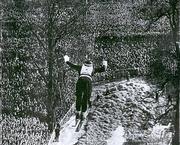Article by Sir George Pollock (1946, GA, SL)
Tan pronto como vi la reseña del libro de Tim Ashburner «Historia de los Saltos de Esquí» en la revista de 2003 (nota: la revista del D.H.O., el club de esquí Downhill Only) supe que era justo para mi, y no perdí tiempo en hacerme con un ejemplar.
The moment I saw the review of Tim Ashburner´s «History of Ski Jumping» in the 2003 journal, I knew it was for me, and I wasted no time in obtaining a copy.
La minuciosa investigación de Tim arroja nueva luz sobre una forma de esquiar que es muy poco practicada por los esquiadores británicos, pero que tuvo una gran influencia cuando el esquí llegó a los Alpes a finales del siglo XIX, y que continuó destacando hasta finales de los años 20 del siglo XX. A día de hoy es fácil olvidar que, en la historia del esquí, las disciplinas alpinas son unas recién llegadas.
Tim´s careful research sheds new light on a form of skiing which is so little practiced by British skiers, but which was very influential in bringing skiing to the Alps towards the end of the 19th century, and which continued its pre-eminence right up to the late 1920´s. From today´s perspective, it is easy to forget that in the history of skiing, the Alpine disciplines were Johnny-come-latelys.

El trampolin de Hampstead Heath de perfil
The 1951 Hampstead Heath Ski Jump in silhouette
The British contribution to jumping was of course much less than to downhill and slalom, but was still disproportionately large for a lowland country. But in the post WW2 era, jumping was almost forgotten by British skiers, until the advent of Tim Ashburner himself and his friends, and later Eddy 'the Eagle'. But even before that there were two events which stirred national interest: the London Ski Jumping Competitions of 1950 and 1951. Both were organised by Norwegians with SCBG and Central Council for Physical Recreation assistance. Both times, the Norwegians brought over 50-60 tons of snow in insulated boxes, and spread it on an 80ft high jump built of steel scaffolding on a hill on Hampstead Heath. The structures were big enough to allow jumps of over 25 meters. Tim mentions and includes a photograph of the first, but apparently did not know that some British skiers were involved.

In fact, the Norwegian Ambassador decided that it would be an attraction to add an Oxford/Cambridge Jumping Competition to the event. He contacted Klaus Huitfeldt of the famous Norwegian family who had invented the Huitfeldt binding, then a student at Oxford and member of their ski team; Klaus telephoned Col. David Horsfield (later Major-General), then Captain of both the British and the Cambridge teams, and it is of him that I owe this information. Horsfield persuaded two other Cambridge team members to take part; one of them, Stuart Parkinson, although a member of the 1948 British Olympic ski team, had never jumped before, and David himself (twice British Ski Champion), had only jumped once, and that on a baby hill! Klaus Huitfeldt led the Oxford team to victory.
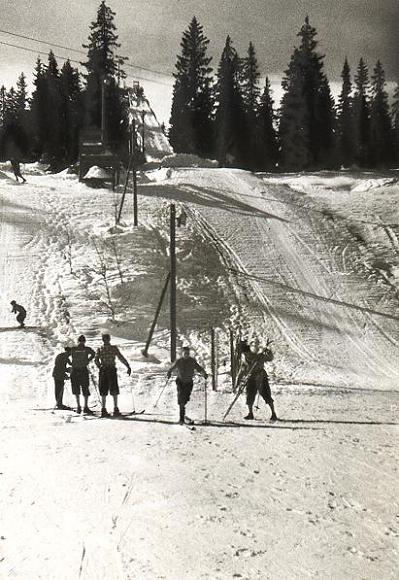
El tampolin de entrenamientos en Frogneseteren, cerca de Oslo
The training jump at Frogneseteren, near Oslo
The success of the 1950 Hampstead Heath Ski Jump prompted the Norwegians to repeat the event in 1951. This time they included the Oxford/Cambridge competition as an official part of the entertainment, and set it up by inviting three skiers from Oxford and three from Cambridge to spend ten days in a lodge near Oslo learning to jump. The Oxford team consisted of Douglas Mackintosh (Captain), John Fox, and Bill Broadhead; I was allegedly Captain of the Cambridge team, the other members being BBC (Ben) Watson and Adrian Cadbury. Of these six, three, Douglas Mackintosh, John Fox and myself, were already members of the D.H.O.: the Index of Members show that we all joined in 1946.

In Norway, our hosts and instructors were the Oslo Skikrets, who gave us a wonderful time. The practice jump was close to the lodge, down a narrow path in the woods. Our guide went ahead and, being on langren skis, turned neatly at a bend. However, to save time, we had put on our skis at the lodge. The first of us just managed the bend, the second turned a bit before running off the path, and third place me ran straight on. My Norwegian being non-existent, I was unable to persuade the handsome spruce in front of me to move out of the way, and in spite of not having been introduced, we embraced vigorously. One of us, I´m not sure which, said «Ouch!» in a meaningful manner. No harm would have been done, had I not been carrying a hard lump of wax in my breast pocket. I was able to carry on, although laughing became painful.

Extendiendo la nieve en el trampolin de Hampstead Heath. A la derecha, una de las cajas aisladas que sirvió para traerla desde Noruega
Laying the snow on the Hampstead Heath Ski Jump. On the right, one of the insulated cases in which it was transported from Norway
Our instructors did their best, but ten days is not enough to learn how to jump competently. Jumping for the first time off a thirty meter hill is frightening enough; but next to our practice hill was a forty meter jump. We eyed this furtively, and wondered whether... in the end, only Douglas Mackintosh dared jump from the bigger hill. The 1951 London jump was a little bigger than the previous year´s, as the organisers hoped that competitors would be able to jump 100 feet, and in fact this was easily achieved by a large proportion of the 32 Norwegians taking part. The best Briton, Douglas Mackintosh, came close with 29 meters (95 ft), and took Oxford to a clear win. Unfortunately, Adrian Cadbury had injured his knee in Norway and was unable to jump on Hampstead Heath, so only five of us performed. Some 60 tons of snow were brought from Norway in insulated cases, carried free in a Norwegian ship, and once here were frozen hard by mixing with dry ice. Snow is hardly a commercial asset, and in English conditions may properly be described as a rapidly disappearing commodity. In spite of all this, Customs and Excise tried to tax it! The national howl of derision that went up provoked A.P.Herbert into writing one of his famous little verses; it appeared in one of the daily papers, but I have been unable to trace it, and after 50 years, all I can remember is part of one line ‘no alien hoar nor rime», and the refrain, which went «Desist, desist, poor humourist, they´ll beat you every time».
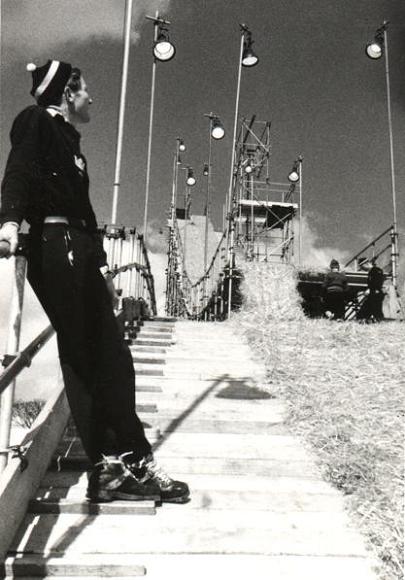
John Fox (Oxford) contemplando el trampolin de Hampstead Heath
John Fox (Oxford) contemplating the Hampstead Heath Ski Jump
A repeat performance is seldom as successful as the first one; even so we attracted 20,000 spectators on the Friday evening, but on Saturday heavy rain put off visitors, so we had no chance of coming anywhere near the previous year´s 100,000 audience. Brief reports appeared in the Times and the Sunday Times, and a photograph in the News Chronicle. A week or so later, a doctor told me I had cracked a rib, so I claim a world record: the only person to have ski-jumped on Hampstead Heath with a broken rib. Funny, the Guiness Book of Records doesn´t seem very interested.
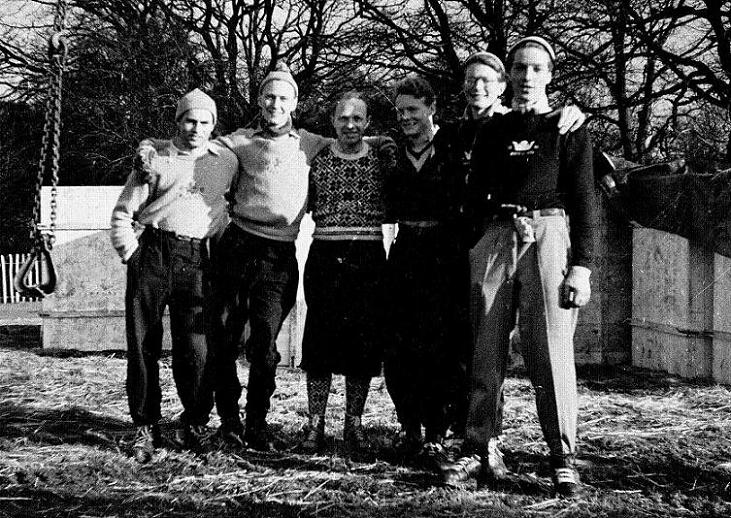
De izquierda a derecha: George Pollock (Cam), Ben Watson (Cam), dos miembros de los Oslo Skikrets, John Fox (Ox) y Bill Broadhead (Ox). Faltan en la foto: Adrian Cadbury (Cam) y Douglas Mackintosh (Ox)
(l-r), George Pollock (Cam), Ben Watson (Cam), two members of the Oslo Skikrets, John Fox (Ox) and Bill Broadhead (Ox). Missing from shot: Adrian Cadbury (Cam) and Douglas Mackintosh (Ox)
El folleto de la prueba de saltos de esqui de Londres, 1951
The catalogue of the 1951 London Ski Jumping Competition
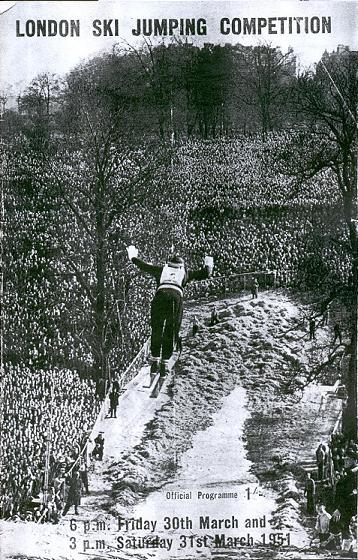

|
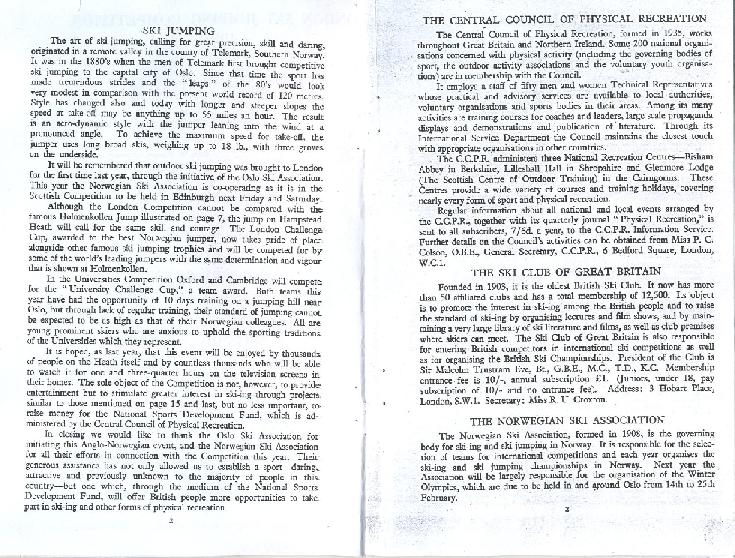
|

|
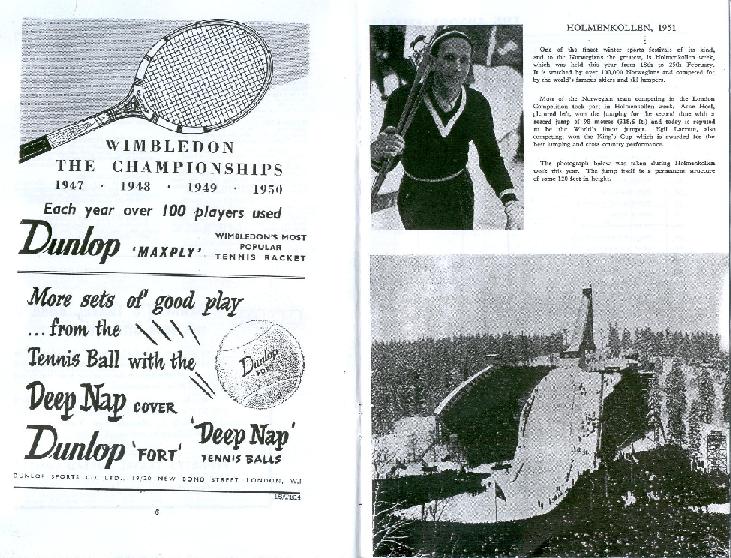
|

|

|
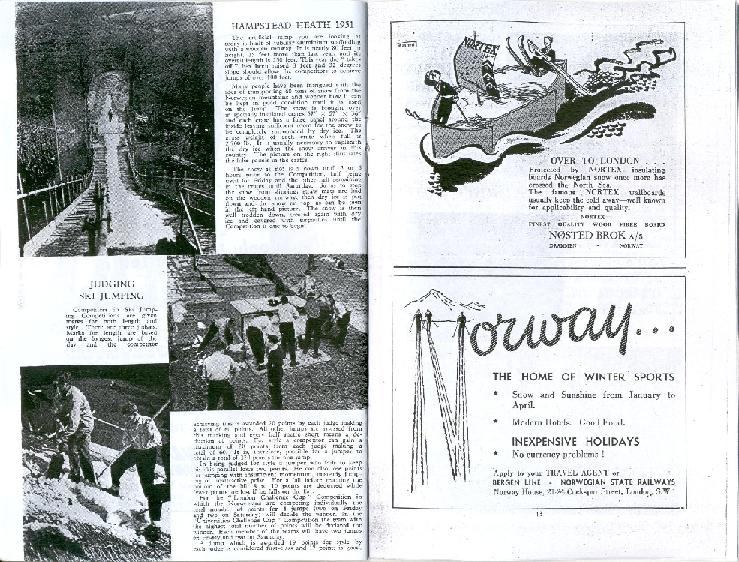
|

|
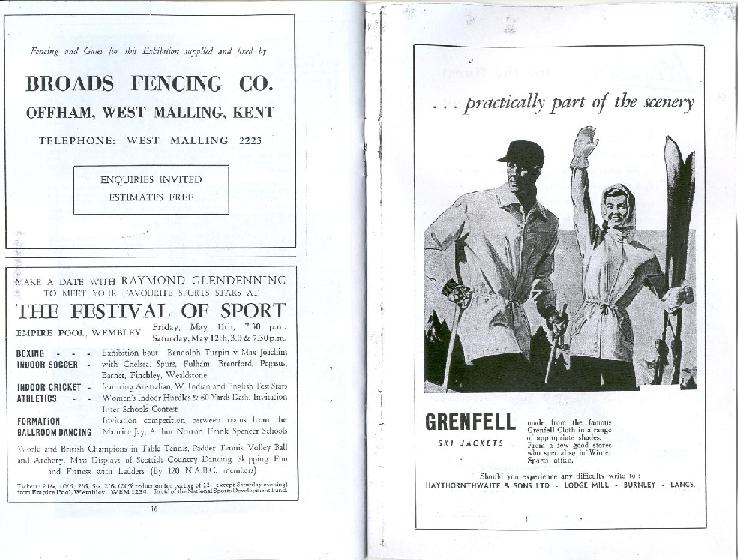
|
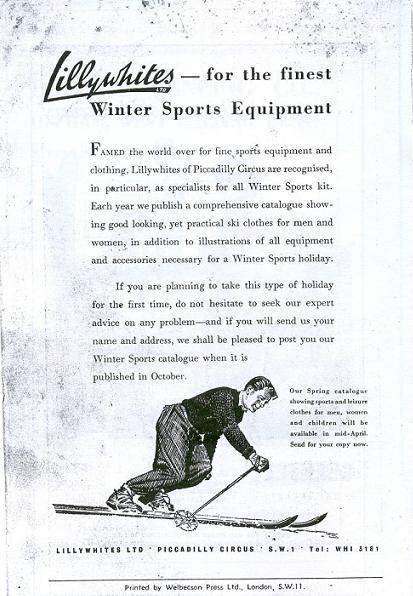
|
Pincha en el Play, para ver un video de esta prueba.
Click on Play to see a short movie
